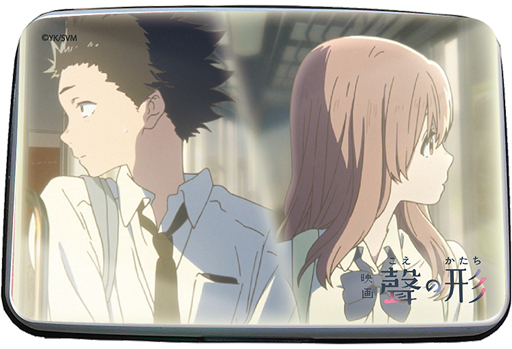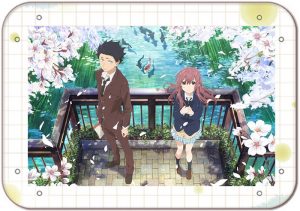
Spoken words are but a fraction of how we communicate. To understand a person, it’s important to learn their individual language—their self-expression. If one can’t understand that language, Koe no Katachi (A Silent Voice) can go quietly and unnoticed.
However, A Silent Voice is hardly quiet.
Sign language, flower language, body language, and film language—so much is said within this film that scenes can go by where so much is said and very little stated. Naoko Yamada is a master of unspoken language, and for this article, we’ll cover her film techniques and signature flower language.
Conveying Words with Film: Perspective and Relative Distance
Film language is another form communication can take. By recognizing film techniques, audiences can become aware of how a story is visually told, recognizing the manner in which a director conveys core themes and ideas.
In A Silent Voice, each character has a unique style of communication, providing a visual challenge for the director. As stated in the first article, even a simple expression of one’s body can be nonverbal (body language) or verbal (sign language) communication. This knowledge allows us to read scenes with more nuance.
With that understanding, we can now approach how a director guides us through a work—how the director speaks and influences our interpretation. One method used in the film is a pillow shot, a cutaway from a scene to (usually) a room or landscape.
Pillow shots are generally held for 5 or 6 seconds and don’t have any immediate narrative value. However, they can influence the tone of an upcoming scene and allow us time to contemplate what happened before.
In A Silent Voice, Naoko uses these shots in combination with flowers. Two examples would be the cyclamen outside the music room and, later on, the cyclamen inside a dream sequence. As long as you can decode flower language, you can get a clue for what the director wants us to understand.
The way a director captures their subjects, close or far, big or small, above or below, can influence a viewer’s interpretation of a scene or character. Typically, characters closer to the camera are considered more important or powerful and characters farther away are interpreted as less important and meek. Vertically, the former is associated with those above and the latter with those shot from below.
Film is an amazing medium, allowing us to see the world through someone else's eyes. Due to this, directors play with perspective often. For example, after Shouya loses his friends and Shouko loses her grandma, both are in a daze, lost about where to go.
At roughly an hour and a half into the film, the Naoko Yamada uses a trip to a museum as a metaphor for the emotional distance. The beginning of this sequence has Shouya and Shouko close to each other. Things seem fine at first, however, this sequence plays like a montage, a somber and muted piano providing the tone.
During the beginning, Shouko speaks, but there is no verbal response from Shouya. Upon entering the museum, there is a section where there are multiple steps that go in all directions. The different elevation makes it so Shouko and Shouya cannot see eye-to-eye. Naoko expands upon this, providing an establishing shot to show the distance between them is widening.
In the next establishing shot, they exit the museum. The distance between them grows to nearly half a screen. Shouya is outpacing Shouko, unaware that he is leaving her behind. As they walk towards a slope, Shouya notices something in the distance. He finally speaks, referring to her by her last name instead of the more familiar first name.
She responds with no words, and Shouya turns around in confusion. As he does so, he remembers the past. It flashes brightly, reminding him of his past actions. In his memory, she is so bright, you can barely see her face. This transitions to a closeup of his face, his guilt apparent.
He walks upwards towards “Nishimiya,” but trips and falls on his face. There’s a quick shot of Shouko’s hands. They fail to catch him, mirroring a prior scene when Shouya fails to catch Shouko’s hands as she falls into a river to catch her journal. This “missing of hands” is like a missing of intentions. During both times, neither character notices the other reaching out.
Shouko uses sign language but without context or translation. In a hurried tone, Shouya denies what she says and asks to hang out tomorrow. As he speaks, the shot is of Shouko from above, her expression obscured by the sunlight. This shot is his mental image of Shouko.
To Shouya, “Nishimiya” is some ephemeral pure figure. She is placed so “highly” above him, that he cannot compare. She reminds him of his past guilt, and despite their physical distance being close now, their emotional distance is widening. The sunlight brightens, and the shot transitions with a fade to white. In the next shot, both characters are sitting close on a train, but neither are looking at each other.
The silence between them says everything, but Shouya reflects upon what she said, “Nishimiya said that I’ll be unhappy if I’m with her. [But] I’m the one who made her unhappy.” The next two shots close out their visit. Shouya has a mental image of his friends. He looks down, seeing only their feet. They turn their backs on him. Cut to another shot, and this time, it’s Shouko who has his back to him.
Flower Language: An Artform and Cryptic Message
Flowers language can differ from culture to culture. In the Victorian era, flowers could communicate feelings through their arrangement, color, and symbolism. The culturally significant red rose can mean love and respect. A white rose, however, transforms its meaning to innocence.
Within Japan, flowers have their own art form and cultural meaning. Hanakotoba is the Japanese form of flower language. Similar to its western counterpart, Hanakotoba can convey emotions without words, a suitable match for A Silent Voice.
In the film, one of the most common flowers is “花火,” (hanabi) the Japanese word for fireworks. When translated literally, it means “flower fire.” in Japanese culture, fireworks have the meaning of fleeting beauty, something that will pass and never come again.
As mentioned in the first article, both Shouko and Shouya’s attempted suicides are framed by fireworks, the former as she is about to jump, and the latter to convince him not to. These “fire flowers” connect them, their pain manifested in a dire moment as Shouya catches Shouko’s hand before she falls. Fireworks bring them together, giving them solace in one another. It’s as if they’re saying, “this fleeting love should stay.”
Another recurring flower is the cyclamen. This flower has multiple meanings, one of which is deep affection. In the film, cyclamen come in two colors. Outside the music room are red cyclamen, and the flower Shouko brings to class are blue cyclamen.
Notably, when the red cyclamen are shown, Shouko starts before her classmates, singing out of tune. The red cyclamen is there as if to say its other meaning: a goodbye, a disconnection. In other words, she is not just musically-challenged, she runs at a tempo that is “off-beat” with her classmates.
This interpretation continues. When Shouko brings blue cyclamen into the class, she does so when Shouya has written something cruel on the chalkboard. While she wants to share “deep affection,” Shouya focuses more on the “deep disconnection.” This divide grows until Shouya gets what he wants—her absence.
However, in exchange, he becomes more disconnected from his classmates, the current victim of their bullying. As he grows up, he experiences the very disconnect Shouko wanted to avoid. It is only after experiencing life through her eyes that he finally yearns for the same thing she wanted.
After Shouya pulls Shouko up from her fall, he falls instead. The result is a physical and metaphorical switching of places. Both have lived isolated lives, yearning for affection. Both have gone through trauma and thought of ending it all. Both have lived two meanings of the cyclamen, but not yet the third.
The third meaning of the cyclamen is a rare or a difficult love to obtain. Naturally, as we approach the movie’s end, we reach this conclusion. After Shouya has been hospitalized, Shouko understands his intentions. Unlike before, where their hands have always missed, his feelings have reached her. Just as Shouya reconnected Shouko to their old classmates, it is now her turn to do the same.
Shouko revisits all his friends, mending his relationships and, in turn, finally mending her relationship with them too. Just as Shouya is recovering in the hospital, Shouko is coming to terms with her past, healing in the process. The movie then makes a logical transition: Shouya’s return. Shouko wakes up from a dream framed with a shot of the cyclamen.
As if called by a strange power, Shouko rushes outside and arrives at a bridge. With miraculous timing, Shouya wakes from his coma, and guided by that same power, he arrives at the same bridge. It is here, somewhere between reality and dreams, that they realize that this “difficult love to obtain” is each other.
Final Thoughts
It’s a strange fact that, despite how much Koe no Katachi, otherwise known as A Silent Voice, influenced me, I’ve never dedicated an article to it. Today, I’ve finally fixed that. In the process of reading both articles, I sincerely hope that my love for this film was conveyed and your interest in the film was renewed or sparked.
Recommended Post


